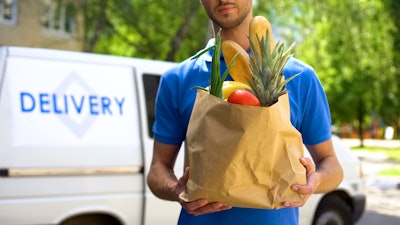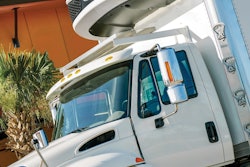
Food waste costs U.S. consumers, businesses and farms over $218 billion per year. Although some of this spoilage isn’t due to refrigeration, cold chain problems play a definite role in contributing to food waste in the U.S. and abroad.
Adding to the challenge, U.S. consumers are now demanding new ways of receiving their groceries—including direct home delivery. Cold chain logistics providers must be able to handle these home driven requests as well as the more traditional transportation routes to warehouses, distributors and grocery retailers.
In October 2018, consultancy KPMG published a survey of 2,000 U.S. consumers, which revealed that while a majority of respondents still preferred in-store grocery shopping, a growing percentage of consumers were starting to order groceries that were directly delivered to their homes. Another finding from the survey showed that frequent online shoppers were attracted to the product assortment, and 25 percent named product quality as the chief factor for buying groceries online. Only 18 percent cited price.
Meeting the Demands of Home Delivery
As online grocery orders grow, more consumers will expect “fresh” versus frozen products. This is accelerating refrigerated food inventory turn cycles, and is forcing significant changes for warehouses, which historically have been able to hold foods longer, and logistics providers, which likewise have worked with warehouses and other distribution points as final destinations—and not with the end consumers themselves.
“To meet the new demands of home delivery, you need to run an end-to-end cold chain, with refrigeration on the last mile,” says Daniel Sokolovsky, founder and CEO of AxleHire, a refrigerated logistics provider. “You also have to be concerned about getting to customers on the first attempt to deliver, because many retailers promise delivery within the first hour of shipping.”
Grocers are responding to those demands. Safeway offers home delivery within two hours of placing an order. Amazon obviously offers home delivery. Instacart delivers groceries in two hours from Whole Foods, Target, Costco and Petco, while services like HelloFresh offer pre-prepared meal plans with home delivery.
“Consumers are willing to pay a premium for one- hour delivery,” says Sokolovsky. “In this market, people are not only getting meal kits, but meals that are fully prepared.”
Additionally, states like California and Florida have companies that offer diet plans with planned meals that arrive at one- and two-week intervals. “All of this has had an impact on the cold chain and on refrigerated logistics providers, because you have to be mobile and agile to meet these home-based needs,” adds Sokolovsky.
Technology to Track and Monitor Perishables
The solution for many refrigerated logistics transporters has been the adoption of more sensors and systems that monitor temperatures of food, and that track delivery trucks on their routes.
“You have to be prepared, and technology is an enabler of this preparedness,” says Sokolovsky. “For example, what happens if a truck breaks down on the highway, and you have one hour to deliver a perishable food order? On time delivery is our No. 1 metric. In these circumstances, you have to have a backup plan when a vehicle fails, so another vehicle can step in and complete the job.”
The consequences of not making deliveries on time, or of delivering goods that are compromised while en route, are expensive returns. Food retailers hold their transporters responsible for this.
In this environment, there are several approaches that logistics providers take to ensure delivery timelines and quality of orders. Among them are:
- Locating transportation near urban hubs, warehouse and retail pickup points;
- Well planned routes that can be flexibly altered;
- Backup transportation in the event of a vehicle failure;
- Sensor monitoring of groceries and truck travel;
- Performance metrics and efforts to continuously improve performance; and
- Well planned handoffs of cargo, especially when it comes to covering the “last mile” of routes.
Route Planning and Customer Satisfaction
Many elements go into planning the delivery of cold chain cargo, says Sokolovsky, especially with more consumers expecting deliveries directly to their homes. “You have to decide the right insulation for the food you are transporting. You want to be communicating with the customer so you can deliver on your first attempt and avoid the risk to freshness that occurs when a customer isn’t present to receive an order the first time you try to deliver. Also, different climate zones require flexible adaptation,” he explains.
For instance, if you’re using insulation that will normally preserve the freshness of food for two days, the same packaging might only last six to eight hours if you’re delivering to a customer in Phoenix, Arizona during the summer when the temperature is 120 degrees.
To carry out these variegated deliveries, the transporter’s logistics system must be seamless, responsive and configured in a way that requires little manual intervention. If an order calls for delivery to a customer between 10 a.m. and 11 a.m. and the first delivery attempt is unsuccessful, this system should be able to reroute a different truck to the stop and alert the customer that delivery was missed the first time but is coming a second time during the original timeframe. This ensures timely deliver because this time a notified customer is at home ready to receive the order.
Sokolovsky says his company also sends out feedback surveys to customers after deliveries. “We want to ensure that our process is working the way that we want it to, and we also want to continue to engage with customers,” he says.
By equipping cargo and trucks with sensors, cold chain transporters can also monitor both vehicle travel and state of goods in a real-time or near real-time mode. This enables a dispatcher at headquarters to receive an alert when a food container that should be kept at 38 degrees suddenly drops to freezing.
“In that case, the alert from the system gets to the dispatcher, who then calls the driver of the truck so the driver can address the problem,” says Sokolovsky. “The same thing happens if we suddenly see a truck en route that gets delayed because it is in unexpectedly heavy traffic. A sensor-generated alert gets sent to a dispatcher, and the dispatcher gets busy. He or she decides if another vehicle needs to get rerouted, or if another driver is needed to take over.”
New Approaches to Home and Apartment Delivery
One of the most difficult situations for cold chain transporters in the home consumer market is ensuring that customers are home to receive perishable groceries when the groceries are delivered.
To address the problem, Sokolovsky says his firm is currently studying the concept of strategically locating “food lockers” around cities where delivered orders of perishable foods could be stored for pickup.
“This concept would provision office and apartment buildings with refrigerated delivery lockers that can store perishable goods if consumers aren’t available for delivery,” says Sokolovsky. “By strategically locating these lockers, and issuing unit codes to consumers that give them access to the bins that store their goods in the lockers, we can avoid missed deliveries and still be sure that the refrigerated goods were delivered to the consumer on time. Each locker can have its own unique temperature setting, so it can be properly calibrated to the refrigeration level required for delivery.”
The locker concept is not yet deployed, and is being reviewed for expense to deploy, cost to maintain, and whether a consumer would be willing to pay an additional fee to have locker storage.
Online Grocery: A Work in Progress
Amazon’s push into the grocery business has already changed how brick-and-mortar stores are selling and delivering refrigerated goods to consumers. However, it’s not Amazon alone that’s changing the game. Diet and convenience online meal kit and prepared meal outlets are also challenging traditional retail grocery stores by offering a greater variety of foods, coupled with timely and perishable goods deliveries to homes, office and apartments.
“The cold chain logistics industry responding to home delivery trends and heated competition among food retailers is in a metamorphosis now,” says Sokolovsky.
He adds that he continues to see traditional brick-and-mortar grocers moving to more online direct-to-home delivery options in order to compete with purely online food retailers, as well as more customers migrating to online ordering of their groceries, with high expectations that the groceries will be delivered on time to them, and in excellent quality.
“This places pressures on cold chain logistics providers, as well as on retail stores to deliver what the market expects,” notes Sokolovsky. “But we are still evolving at a time when nobody really knows yet what consumers want, because the home delivery market is still in an early stage of development…There are many different approaches that can be taken. The main question we must ultimately answer is—how do we make this happen? This is what we are positioning ourselves to do.”















